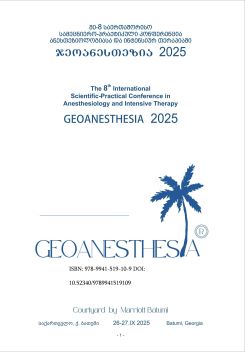THE INNOVATIVE ROLE OF TRANSCRANIAL ULTRASOUND DOPPLER (TCD,TCCS) IN INTENSIVE CARE (ICU) AND ANESTHESIOLOGY-RESUSCITATION
DOI:
https://doi.org/10.52340/9789941519109.06Keywords:
TCD/TCCS, ICP, Cerebrovascular Arrest, Vasospasm, Microemboli, Recanalization, ICUAbstract
TCD/TCCS are fundamental neurosonological modalities that have become indispensable in the management of critically ill patients [1,2]. Their non-invasive, portable, and repeatable nature enables real-time cerebrovascular monitoring directly at the bedside. Beyond their traditional use in stroke medicine, these modalities provide early diagnostic, preventive, and monitoring advantages across a broad spectrum of intensive care and anesthesiology-resuscitation contexts [3].
In the ICU, TCD/TCCS and carotid Dopplerography are increasingly applied for the evaluation of acute thrombosis and arterial dissection, early detection of intracranial pressure (ICP) elevation through flow waveform alterations and increased pulsatility index (PI) [4,5]. In ophthalmic neurosonology, optic nerve sheath diameter (ONSD) measurements serve as a validated proxy marker of raised ICP and providing a non-invasive tool where invasive monitoring is not feasible [6]. TCD/TCCS support the diagnosis of cerebrovascular arrest, characterized by systolic spikes in basal arteries, offering a reliable, bedside solution [7,8].
Vasospasm monitoring following subarachnoid hemorrhage and traumatic brain injury is among the most established applications. Progressive increases flow velocities in the basal cerebral arteries, in combination with Lindegaard ratio calculations, allow differentiation between cerebral hyperemia and vasospasm [9,10]. Continuous bedside monitoring with TCD contributes to timely therapeutic interventions and prevention of delayed cerebral ischemia. TCD also plays a central role in the assessment of recanalization after intravenous thrombolysis or mechanical thrombectomy, where standardized grading systems such as the Thrombolysis in Brain Ischemia (TIBI) flow grades indicate the presence, timing, and quality of restored cerebral perfusion [11,12].
Another crucial innovation is microemboli detection, based on the identification of high-intensity transient signals during TCD monitoring. This technique has significant clinical implications in carotid atherosclerotic disease, cardiac shunts and intensive care, as it allows stratification of embolic risk, monitoring of treatment efficacy, and reduction of ischemic events [13,14].
In anesthesiology and perioperative practice, TCD serves as a valuable adjunct for monitoring cerebral autoregulation and perfusion during neurosurgical and cardiovascular interventions [15]. It enables intraoperative detection of cerebral emboli during carotid endarterectomy or cardiopulmonary bypass, facilitates identification of hypoperfusion and hyperemia during aortic arch surgery, and assists in evaluating the influence of anesthetic agents on cerebral vasomotor tone [16]. TCCS complements this role by providing structural orientation of ventricular dilatation, midline deviation, and acute hematomas, thereby enhancing intraoperative decision-making and perioperative brain protection [17].
The advantages of TCD/TCCS expand the reach of point-of-care ultrasound (POCUS) into neurocritical care, promoting the development of Neuro-POCUS frameworks that integrate cerebral hemodynamic assessment into multimodal critical care and anesthesiology practice [18].
The integration of AI and robotic ultrasound with cerebrovascular monitoring will further enhance neurosonology. Automated vasospasm detection, emboli classification, and waveform interpretation are likely to reduce operator dependence and support continuous monitoring. These technological advances may enable personalized, real-time cerebrovascular profiling in critically ill patients [19,20].
In conclusion, transcranial ultrasound techniques represent a truly innovative, preventive, and physiologically grounded approach to brain monitoring in ICU and perioperative settings. TCD/TCCS provide unique bedside access to cerebral circulation pathology. Their integration into multimodal monitoring frameworks underscores their indispensable role in intensive care and anesthesiology.
References
Aaslid, R. (1986) Transcranial Doppler examination techniques. Springer, Vienna.
Alexandrov, A.V. (2012) Practical Models of Neurosonology. Cambridge University Press.
Bellner, J., Romner, B., Reinstrup, P., Kristiansson, K.A., Ryding, E. & Brandt, L. (2004) ‘Transcranial Doppler sonography pulsatility index (PI) reflects intracranial pressure (ICP)’, Surgical Neurology, 62(1), pp. 45–51.
Zweifel, C., et al. (2010) ‘Noninvasive monitoring of cerebrovascular reactivity with near-infrared spectroscopy in head-injured patients’, Journal of Neurotrauma, 27(11), pp. 1951–1958.
Robba, C., et al. (2018) ‘Optic nerve sheath diameter ultrasonography for raised ICP: a systematic review and meta-analysis’, Intensive Care Medicine, 44(8), pp. 1284–1294.
de Freitas, G.R. & Bogousslavsky, J. (2001) ‘Diagnosis and management of brain death’, European Neurology, 45(3), pp. 141–149.
Wijdicks, E.F.M. (2011) Brain Death. Oxford University Press.
Lindegaard, K.F., et al. (1988) ‘Cerebral vasospasm diagnosis by means of angiography and blood velocity measurements’, Acta Neurochirurgica, 90(1–2), pp. 35–39.
Vora, Y., Suarez, J.I., et al. (1999) ‘Vasospasm after subarachnoid hemorrhage: TCD and angiographic correlation’, Journal of Neuroimaging, 9(1), pp. 11–18.
Demchuk, A.M., Christou, I., Wein, T.H., Felberg, R.A., Malkoff, M., Grotta, J.C. & Alexandrov, A.V. (2000) ‘Accuracy and criteria for TCD diagnosis of middle cerebral artery recanalization’, Stroke, 31(4), pp. 1123–1128.
Christou, I., et al. (2001) ‘Timing of recanalization after thrombolysis in acute ischemic stroke: a TCD study’, Stroke, 32(2), pp. 263–267.
Ringelstein, E.B., Droste, D.W., Babikian, V.L., Evans, D.H., Grosset, D.G., Kaps, M., Markus, H.S., Russell, D. & Siebler, M. (1998) ‘Consensus on microembolus detection by TCD’, Stroke, 29(3), pp. 725–729.
Markus, H.S. & Brown, M.M. (1993) ‘Differentiation between cerebral emboli and artefacts using Doppler ultrasound’, Journal of Neurology, Neurosurgery & Psychiatry, 56(5), pp. 539–543.
Newman, M.F., et al. (1996) ‘Cerebral emboli during cardiopulmonary bypass’, The New England Journal of Medicine, 335(24), pp. 1735–1740.
Momjian-Mayor, I. & Baron, J.C. (2005) ‘Cerebral hypoperfusion and the ischemic penumbra’, Stroke, 36(6), pp. 1074–1086.
Seidel, G., et al. (1995) ‘Structural imaging with TCCS in neurosurgery’, Journal of Neuroimaging, 5(2), pp. 121–127.
Robba, C., et al. (2019) ‘POCUS in neurocritical care’, Critical Care, 23(1), p. 19.
Koep, M., et al. (2023) ‘Artificial intelligence in cerebrovascular ultrasound: current status and future perspectives’, Frontiers in Neurology, 14: 1160341.
Chen, X., et al. (2024) ‘Deep learning for automated vasospasm detection in TCD’, Journal of Stroke and Cerebrovascular Diseases, 33(2), p. 106072.





